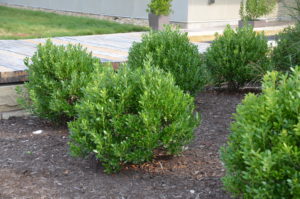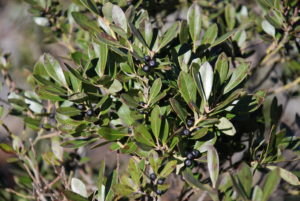
Ilex glabra ‘Densa’
Inkberry holly (Ilex glabra), also called gallberry, is a slow-growing broadleaf evergreen shrub (USDA hardiness zones 4-9). It grows to 5-8 feet tall and can spread by root suckers and form colonies. Inkberry is native from the eastern coast of Canada south to Florida, west to Louisiana. The shrub is at home in sandy woodlands and edges of swamps and bogs.
The small, dark green, glossy leaves (to 1.5 inches long) are smooth edged without any spines. Foliage stays attractive in winter unless temperatures dip below 0 °F. Greenish white flowers appear in spring, but are mostly inconspicuous. Jet black, berry-like drupes (3/8 inch diameter) mature in early fall and persist throughout late winter into early spring unless eaten by birds and other wildlife.
Inkberry hollies are popular hedging shrubs that look like boxwoods (Buxus spp.). Their growth rate is greater than boxwoods. This durable shrub grows in average, medium to wet, acidic soils and in full sun to partial shade. It is one of few holly species that tolerates wet soils.
Inkberries are dioecious, either male or female plants. Female plants need a male pollinator in order to produce the berry-like drupes that are characteristic of the species and cultivars. Prune in early spring before new growth begins. Plants generally need minimal pruning unless used as a hedge. Remove root suckers if undesired.
No serious insect or disease problems trouble inkberry hollies. Leaf spotting occurs in wet summers. Spider mites may appear, especially during dry weather.in high pH (alkaline) soils, foliar chlorosis (yellowing) may happen. Spider mites may appear, especially in hot dry weather.
Mass or group several inkberry hollies as a shrub border, a low foundation planting. Species inkberries will naturalize in moist woodland gardens or near streams or ponds. Fertilize in spring with an acidic water soluble fertilizer such as Holly-Tone® or Miracle-Gro®.
When shopping at local garden centers, ‘Densa’, ‘Nordic’, and ‘Shamrock’ are popular cultivars. Densa inkberry holly is a female clone, but any male holly should be able to pollinate the flowers. All exhibit dense branching, compact growth habit, and less root suckering compared to the species. Avoid varieties that become “bare-legged” or “raise their skirts”.
Honey derived from inkberry flowers is a highly-rated; it is locally marketed at some farm markets in the southeastern U.S. Dried and roasted inkberry leaves were first used by Native Americans to brew “Appalachian tea” a black tea-like drink.


 Posted in
Posted in 
